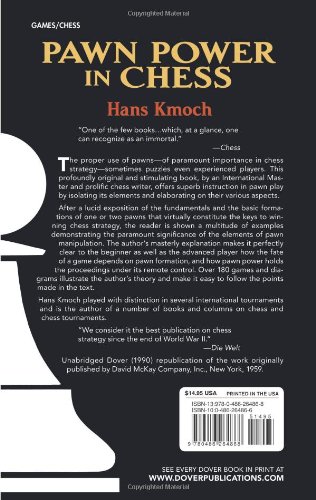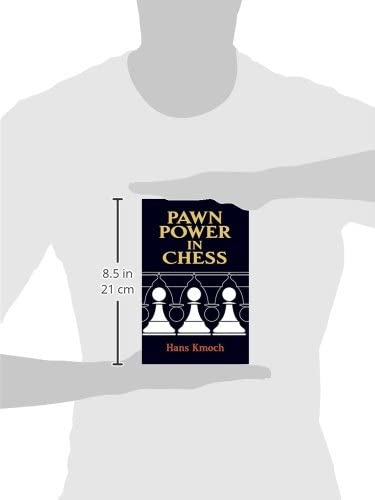معلومات عنا
حقوق الطبع والنشر © 2024 Desertcart Holdings Limited





Pawn Power in Chess (Dover Chess)
R**L
Truly a Classic and one of the best book about Pawns!
You would initially be turned off due to the use of the old Descriptive notation and the coined jargon that he made in the book. I think he is just trying to be exact and precise in his terms, which could be good or bad depending on how you look into it.Anyway, going over that, I find this book to be one of the best in terms of pawn structure understanding and how to play based on the structures. With good backing of classical games.You just need to get over the initial shock and learning curve, but it would be all worth it. A lot of very strong Grandmasters have recommended this book, and it is really highly recommendable!
J**L
Pick Up Pawn Structure Chess if you can find it instead.
This book uses some non-standard chess terminology that sometimes confuses as much as it clarifies. Know what a pawn lever and pawn ram are? The author does a reasonable job of presenting ideas, but I feel that some of the terminology doesn't translate into English well from the native German. Much of the book's criticism is often responded to with "You really should read it in German!" It's really too bad that a top notch translation doesn't exist. I think I could excuse the language if I felt that it made the examples either stick in memory better or revealed deeper explanations. As it is, I prefer pawn islands, isolated pawns, connected pawns, and passed pawns to pawn levers, pawn rams, and pawn duos. At the end of the day, I'd like to be able to discuss what I have learned with others, and unless they have read Hans Kmoch or you have read the more widely accepted definitions, this communication between enthusiasts will be harder than it needs to be.Reading the book will increase play strength (assuming that you haven't internalized these ideas in other forms), but it predates the modern focus on chess dynamics. In some ways this dynamics is in the book and predates wide acceptance of dynamics. The pawn levers topics discuss when two opposing pawns are placed that either may capture. These levers are a big portion of the work, and studying them has real merit. This perspective may not be so thoroughly covered by other authors, but the concept of duo (connected pawns) is widely recognized now. Entire books have now been written (quite well) about isolated pawns. To be fair, there is much to be recommended. Master this book, and your play is bound to improve.Another consequence of its age is that it uses descriptive chess notation rather than algebraic. This is a minor sticking point for younger readers, and perhaps no issue at all for older readers.Overall, as competition with other works increases, I find it harder and harder to recommend this book. I do recommend it, but with qualification.
R**L
Kmoch's immortal classic text on pawn play
In my opinion Hans Kmoch's Pawn Power In Chess is an immortal classic of the chess literature, and every serious chess player would do well to study it. Here are the fundamental elements of what you need to know about how to effectively use your pawns - primarily (though not exclusively) within the context of middlegame play.Although the usage of the outdated "Descriptive" chess notation (of the Dover Publications edition), and the somewhat quirky, but apt, terminology used to describe structures and concepts may require getting acclimated to, study of this book (in particular the first 6-7 chapters, which embody its essence) will continue to pay dividends throughout your chess career.There was an algebraic edition of Kmoch's book published in 1990 by American Chess Promotions. One can quickly find it by searching (e.g., on Amazon) on the ISBN number - "ISBN 0939298791”. Except for the use of Algebraic notation, the contents of the book are identical to the Dover edition.
Z**N
To find the treasure you have to dig
I have read many chess books. As my rating is only in the 1700's I am by no means an expert. I am however a person who enjoys chess, studies chess, and wants to know more. I am also a person that is not so committed that I want to drag out a chess board and study every possible variation of a position. When I look for chess books I look for ones that are easy to read focusing on concepts more than variations. For this reason I really enjoyed Silman's Endgame Course. Probably the most impact for the buck on your game. However I've learned that the player who understands Pawn Structure is better prepared. It guides you, shows you a plan of action, sets you up for success, etc. Understanding End Games and Pawns are the keys to winning!So: This book is good. It provides the concepts of Pawn Play. It is easy to understand without too many variations to dig through. The only negative is that he first creats his own vocabulary for you to follow. At first it is daunting to learn so many new terms, but there is a method to his madness. once you understand the language he is using the concepts and ideas become very clear and more importantly...useful!enjoy
R**.
less a religious revelation than a new way of thinking
When I was 20 years younger and my rating was 300 points lower (but I feel as though my play was 3000X more interesting), I continually ran into folks who said that they really advanced their game by reading Pawn Power in Chess. Finally, I got around to reading it. It has some really useful insights into how to think about pawn chains. I didn't find that it had the miracle cure for their rating that those who recommended the book apparently had, but it's good to see a systematic way of thinking about pawn structure in a simple guide, even if the Benoni structures given much attention here are not structures that appear much in my simple-minded games. A good read, an interesting concept, not quite a religious revelation.
L**
Good…
If you don’t mind reading descriptive notation and older literature, then this book will be great for you!
R**O
Excelente Libro !
Es un excelente libro. Trata con mucha precisión sobre los distintos conceptos relacionados con los peones y está escrito en un estilo muy didáctico. No le puse cinco estrellas porque requiere aprender mucha terminología inventada por el autor que hasta donde entiendo no se había usado antes y no se ha vuelto a usar, y eso requiere un esfuerzo adicional. Aún con este aspecto relativamente negativo, me parece que el libro vale la pena ser leído. Por último, para ser justos, habría que saber si el autor hubiera podido dar una explicación tan clara sobre los peones sin tener que definir los términos que usa; tal vez sin esos conceptos no hubiera podido ser tan preciso.Saludos,
A**A
Good
Written in descriptive notation, it requires some practice before we become familiar with the simbology. However, all in all an interesting text on a peculiar issue in chess.
C**R
Fundamental este aprendizado para quem deseja se tornar um forte enxadrista.
Todos deveriam ler exaustivamente e certamente se tornará um jogador muito forte.
C**R
As advertized - great book
Great for helping to build a structured understanding of how to create more effective pawn structures and tactics, with very foundational instruction - you don't have to be an expert to understand a lot of this.
ترست بايلوت
منذ شهر
منذ يوم واحد